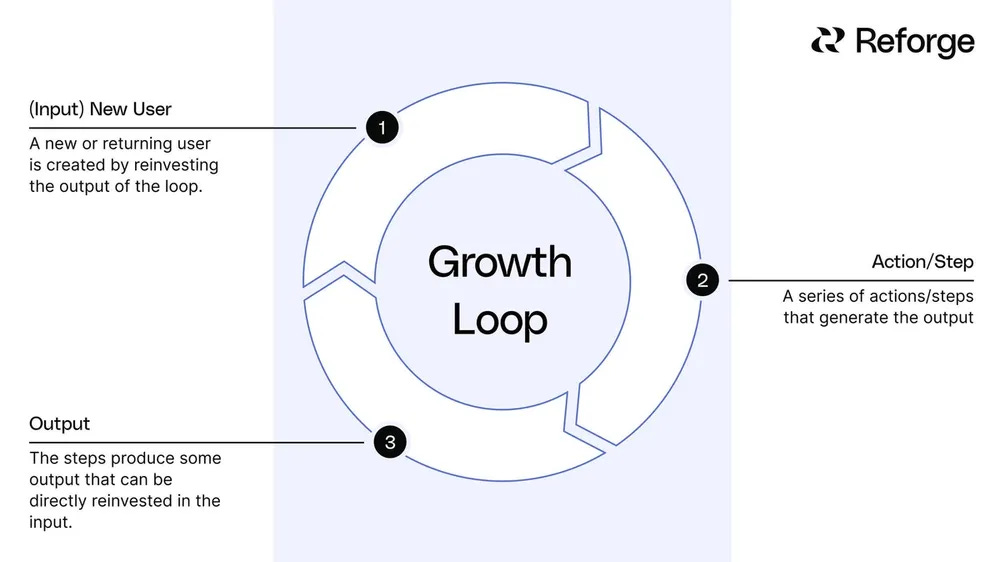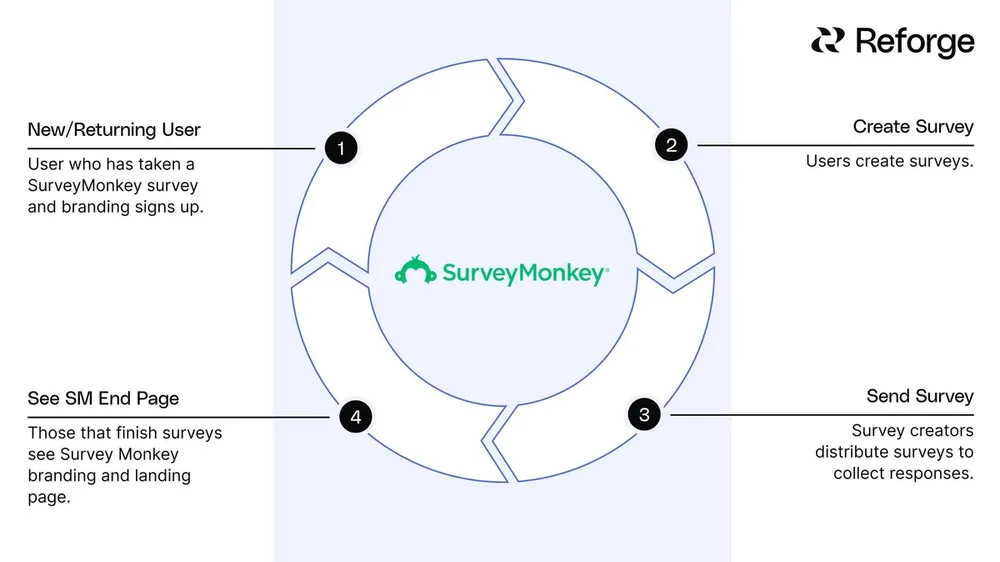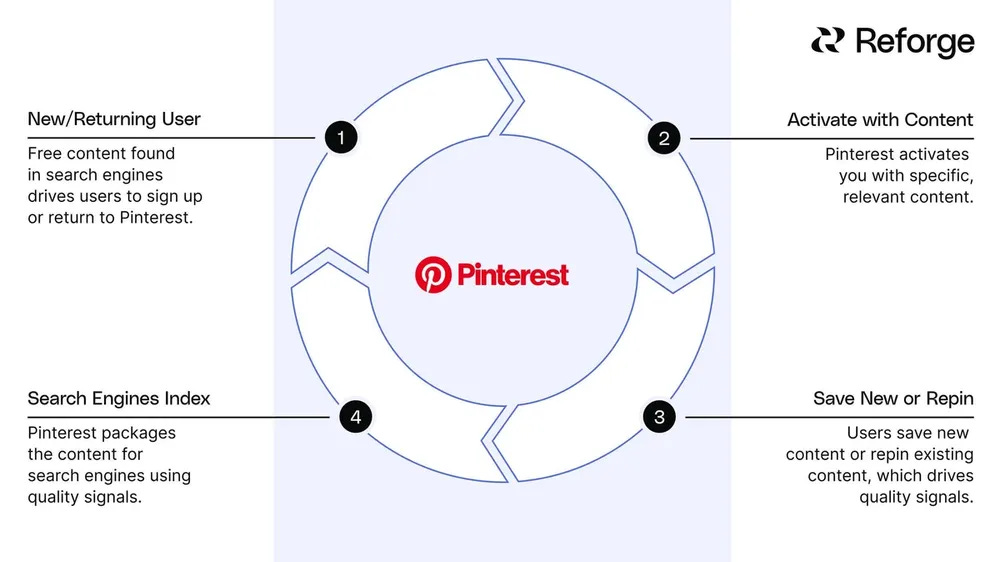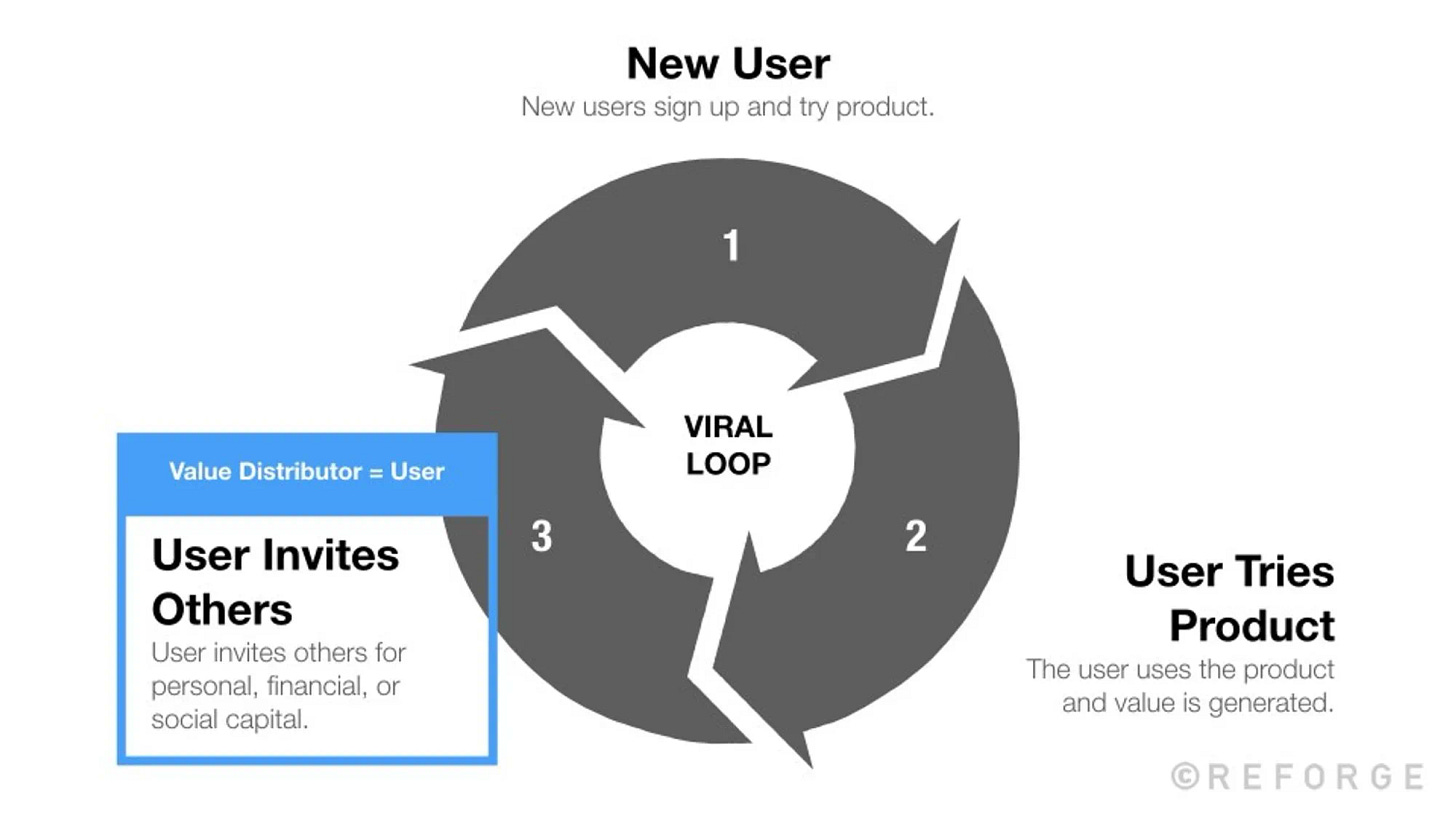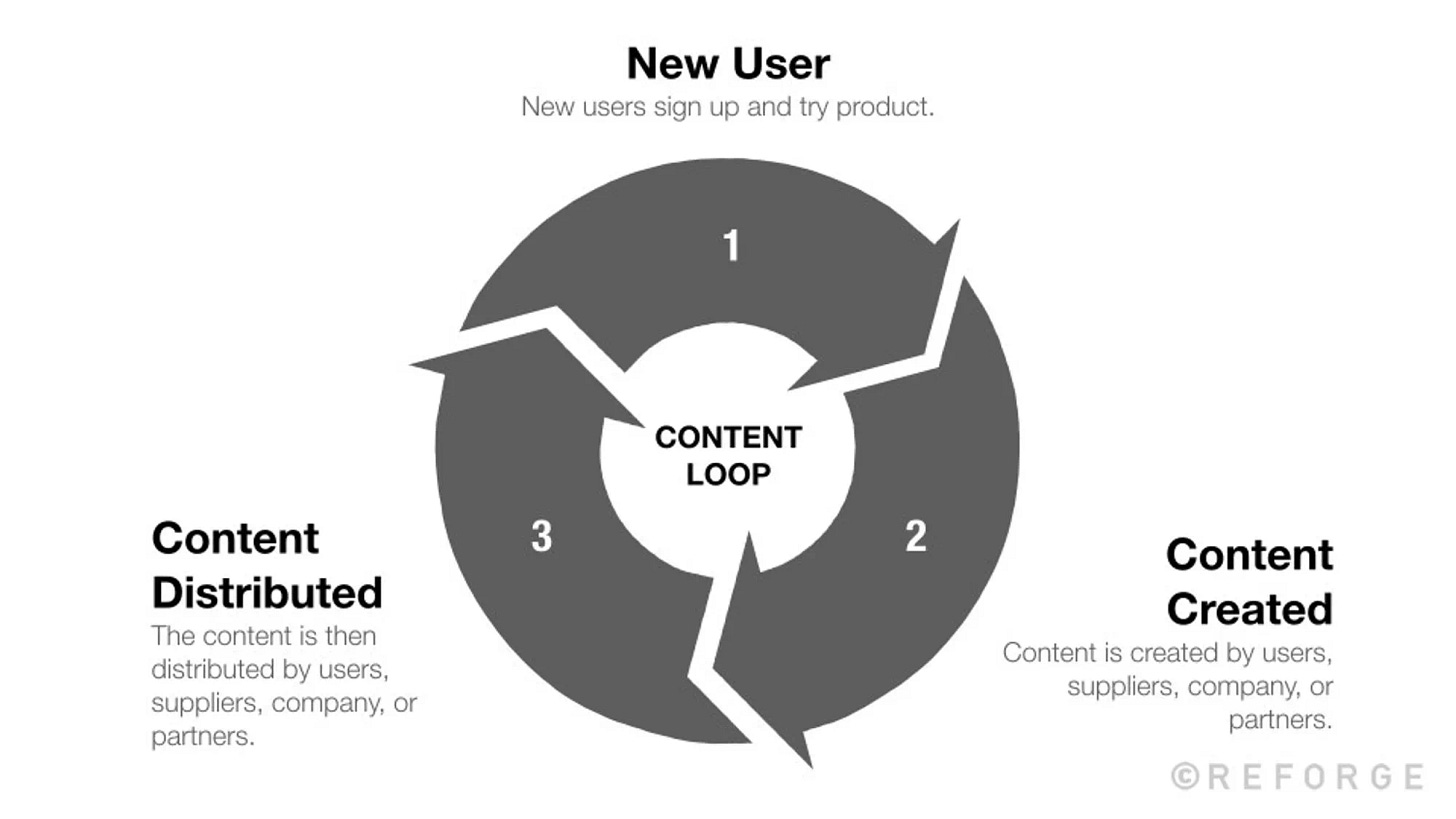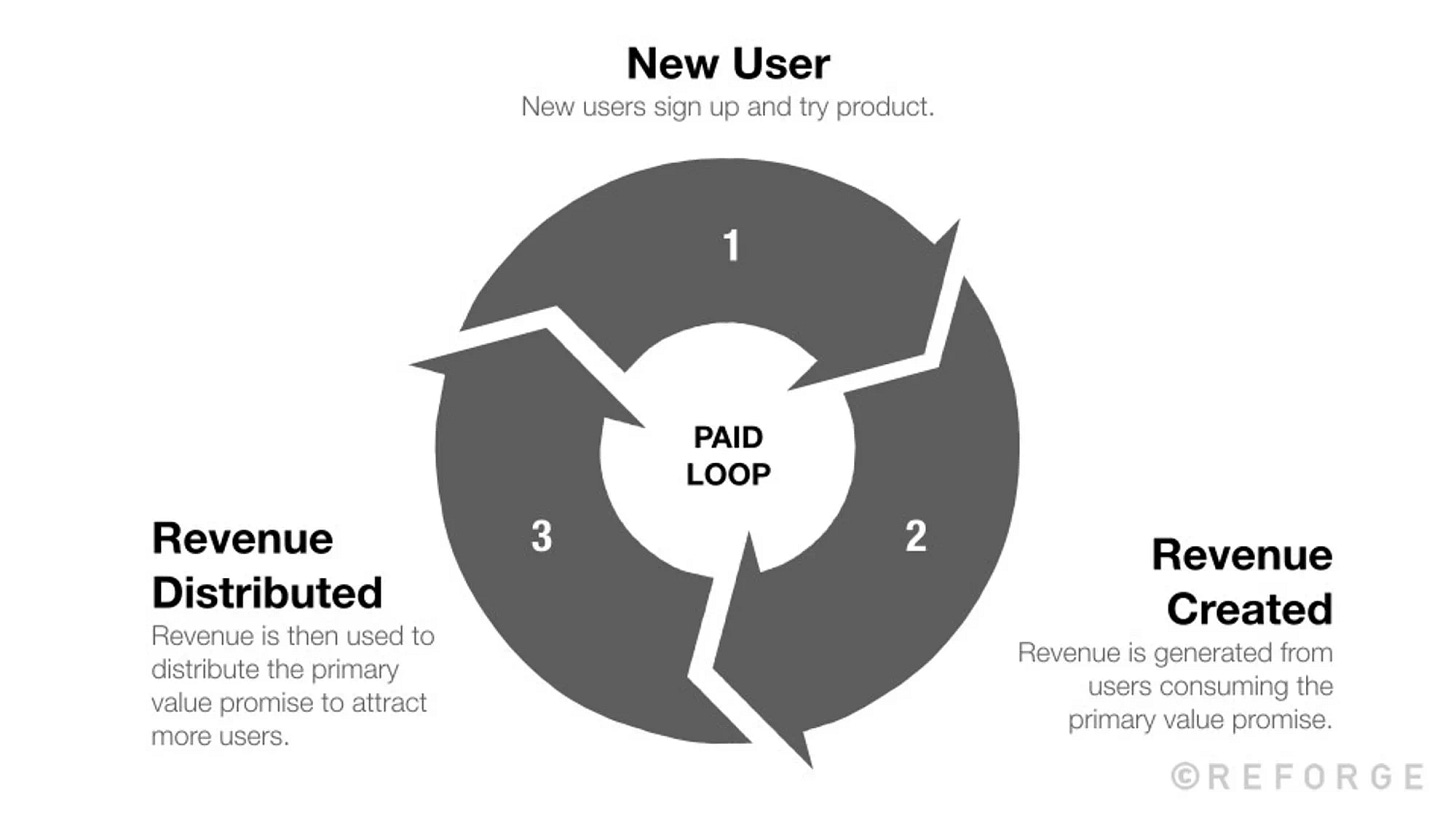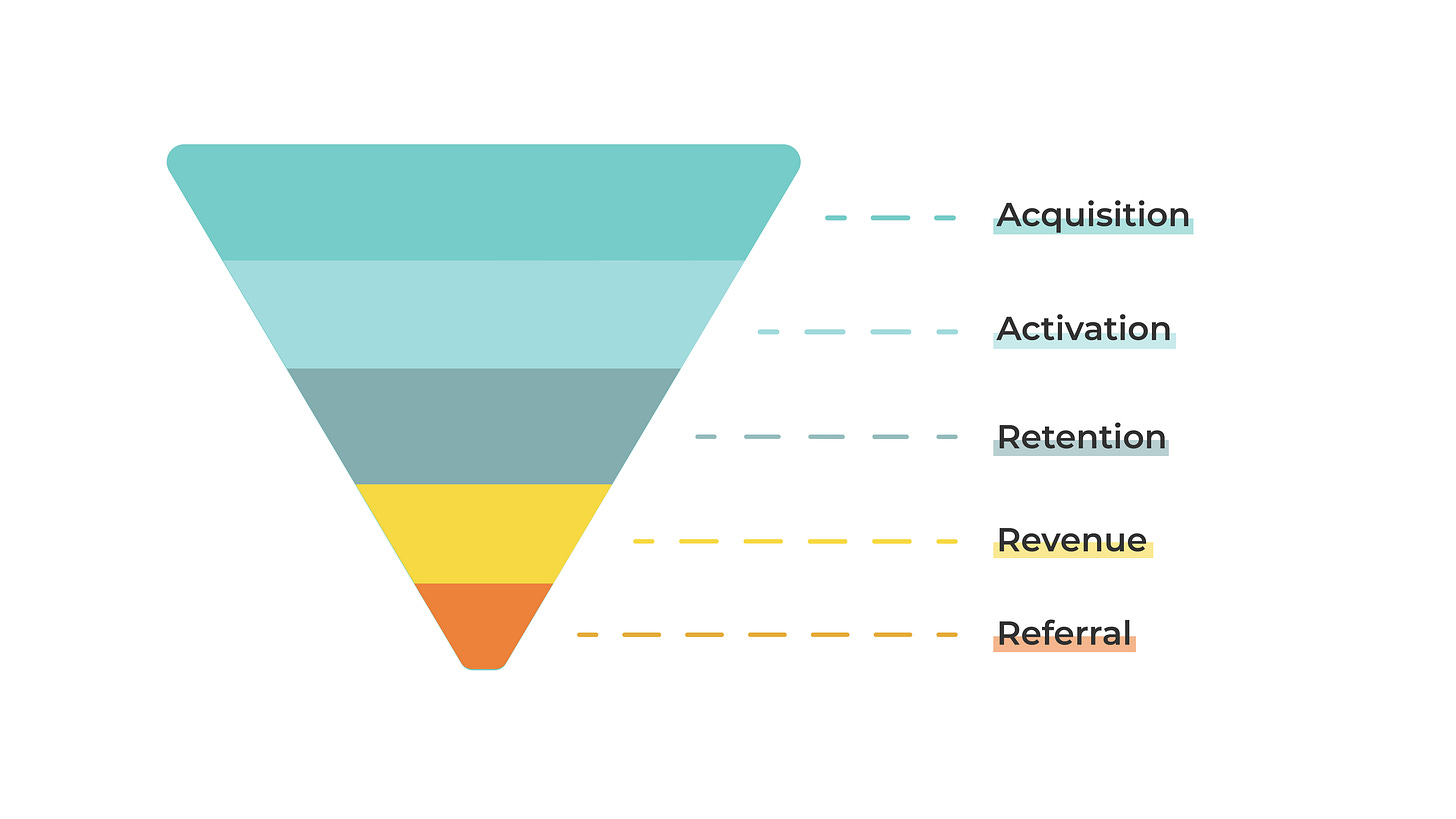From Funnels to Growth Loops
And why you should look to move beyond the traditional AARRR funnel
The topic of “loops,” particularly those related to growth, is probably one of the most interesting for me to deep dive into. It’s also something I’m constantly exploring because building any growth loop is both an art and a science.
In this post, I will focus more on the foundations of loops and why you should invest time and money into building them for your business instead of being stuck measuring funnel activity.
Let’s dive in.
What is a Growth Loop?
The most obvious question to start with - what is a loop?
Loops are self-contained systems where the inputs, through a certain process, produce outputs that can be reinvested back into the system. There are various growth loops that contribute to different types of value creation, such as attracting new users, retaining returning users, enhancing defensibility, or improving efficiency.
This might look a bit complex at the beginning, but it’s actually quite straightforward once you go through a few iterations.
A new or returning user is created from the previous step (reinvesting the output of the loop).
The user needs to take a single action or a series of actions, which generate the output.
The final piece is the output, produced from the previous step, which is directly reinvested in the input.
Let’s look at a few simple examples from real-world companies.
SurveyMonkeySurveyMonkey’s loop primarily focuses on the “survey” aspect, as this is the core of their business.
New or Returning User → those who take a survey and click on branding sign-ups.
Create the Survey → this is the product action any user needs to perform.
Send the Survey → the user distributes the survey and collects responses.
People See SurveyMonkey End Page → once survey invitees complete it, they see SurveyMonkey branding and may click on it.
PinterestPinterest’s loop primarily focuses on the “Pin/Repin” action.
New or Returning User → users find free content through search engines (primarily Google) and click to sign up or return as existing customers to Pinterest.
Content Activation → the activation piece is important here, as it allows users to get specific and relevant content.
Core Action → the user “saves” or “repins” existing content, signaling quality.
Search Engine Indexation → Pinterest packages the content and prepares it for search engines to crawl and index.
There are more examples for growth loops from some of the best both B2B and B2C companies.
Types of Growth Loops
Growth loops can be seen across multiple categories and sub-categories.
Next, we will dive deep into each of them.
Viral Loops
At its core, every viral loop is distributed by the user. An important element here is that the user needs to try the product, get value from it, and then invite others with either a financial or non-financial incentive.
There are 3 types of viral loops:
Personal → This is known as “organic virality” and is usually related to personal gain. Distribution happens when the people you invite use the product.
Companies doing this: WhatsApp, Dropbox, Slack
Financial → This is known as “incentivised referrals” and the user is seeking monetary value by inviting others to the product.
Companies doing this: Robinhood, Uber, Airbnb
Social → This is known as “word of mouth (WOM)” and the user gains social capital by inviting others.
Companies doing this: Tinder, Stripe
Content Loops
A content loop is when content is generated from some usage of the product, and it is distributed to attract more usage.
If you want to really understand the core difference between the content loop and other loops, such as viral loops, you need to know that the content loop is primarily driven by the amount of content flowing through it. This can be a powerful tool for your efforts because if the quantity suddenly drops, the loop will not spin in the same way.
With the content loop, there are two main questions you need to answer before starting to develop one:
Who is creating the content?
There are 3 sources that can create the content: company, users and suppliers.
Who is distributing the content?
Here, you have branches for each content creator mentioned above:
Company ( CGC ) > Users, Suppliers and Company
Uses ( UGC ) > Users, Suppliers and Company
Supplier ( SGC ) > Users, Suppliers and Company
Understanding the different combinations of who creates the content and who shares it is important. These combinations affect things like costs and revenue.
An example from G2 Crow, to give you an idea.
Paid Loops
In basic terms, paid loops are built where money is generated from using the product and, more importantly, reinvested in a way to attract more usage.
While the primary constraint in viral loops is the users, and in content loops, it is the content, in paid loops, as you might guess, it is the available capital.
Paid loops differ based on how the money made is reinvested to provide different levels of the main value promised.
Like the other two loops, paid loops also have ways to branch out and serve different needs.
Ad Loop → We all know this one as SEM or paid marketing. The idea is to use a certain budget to convert and generate more revenue, reinvest that revenue to reach even more users who will drive even more revenue… until the loop ends.
Sales Loop → Here, the loop focuses more on generating revenue to hire more sales reps who distribute the value promise.
GAINSIGHT is a great example
Integration Loop → As the name suggests, the money made here is reinvested to create more integrations. These integrations are then distributed to provide the main value promised to more customers.
ZAPIER is a perfect example here
Why Don’t Funnels Have The Same Impact Compared to Loops?
Growth Funnels
We are getting to the point in the article where I will show why loops are better than the traditional AARRR funnel we all know and still use today. Of course, this is all based on my point of view and experience.
For reference, this is an AARRR funnel today
The most obvious issue for me is that each layer in a funnel is standalone and faces one direction - down. This mirrors the way we structure our teams:
Acquisition - owned by Marketing
Activation and Retention - owned by Product
Revenue - owned by Sales
Do you see the problem already? Each team depends on the others to perform well, so they can do well too. But what actually happens is that each team optimizes at the expense of the others in order to reach their own goals.
I cannot stress enough the number of times I’ve been in meetings where Product blames Marketing for “low or poor-quality users” or Sales blames Product for “an unclear product that confuses users or lacks feature X.”
The second point is that there is no overall strategy for scaling the entire business, only specific parts of the funnel. If everyone works independently, they create roadmaps based on their own needs. For example, the Product team, which owns the roadmap, goes ahead and plans what THEY need the most without considering other departments and the overall picture.
A few of my favorite “quotes”:
“We don’t have resources to build everything.”
“We prioritize features that our users want.”
“Perhaps we can move your requests to the next quarter, or even next year.”
So, if you are not part of the Product team, how would you feel? How would your teams feel about reaching their targets?
Finally, I would say that funnels are not built to rely on the 8th wonder of the world: the compounding effect.
If you think logically, once a user goes all the way through the funnel, what happens after that? Very rarely do you hear conversations about “reinvesting” or how to get more users without increasing costs, people, tools, or channels.
In my opinion, Marketing often gets the most pressure, as they need to scale top-of-the-line numbers rapidly every year for the whole funnel to work. This is an absolutely wrong and unsustainable approach.
Growth Loops
On the other hand, we have growth loops.
Let’s see why they are better investments than funnels. I have in mind four core reasons.
1. Continuous Feedback: Growth loops are self-sustaining, generating continuous feedback that fuels further growth. Unlike the AARRR funnel, which ends at retention, growth loops create ongoing engagement and user acquisition.
2. Holistic Approach: Growth loops integrate various stages of the user journey into one cohesive cycle, not silos. This holistic view contrasts with the segmented stages of the AARRR funnel, leading to better synergy and overall performance. Teams working on loops are usually from various departments and share common metrics.
3. Sustainable Growth: By leveraging new and existing users to attract more users, growth loops focus on sustainable, long-term growth. It is important to recognize that we are not talking about “quick growth hacks.” In contrast, the AARRR funnel often requires a continuous input of new users to maintain momentum.
4. Efficiency: Growth loops maximize the efficiency of resource use, creating more output from the same or fewer inputs. This also means we don’t need to increase budgets but just get better at conversions and spinning the loop. The AARRR funnel, with its linear progression, can be less efficient as each stage is isolated and may require separate resources and strategies.
How to Identify & Start Building a Loop?
So you are sold on investing in growth loops, but then comes a good follow-up question: How do you spot loop opportunities and what is the process to build one?
Let’s start with how to identify a potential loop opportunity
The first thing you can do is analyze your existing processes by looking at your current strategies for acquisition, engagement, and retention. Look for areas where user actions naturally lead to attracting new users or keep current users coming back.
I call this “finding natural feedback loops,” because it involves looking for existing user behaviors that create value both for themselves and for attracting new users, such as UGC (User-Generated Content) or referrals.
The second step is the one that I love the most: mapping and understanding your customer journey. Map the journey to its smallest detail in order to pinpoint where users can take actions that generate value.
Look for stages where encouraging certain behaviors can lead to a continuous loop of user acquisition and engagement.
The third thing you can do, and something I’ve done several times, is to look for external inspiration. Benchmark successful companies and analyze their growth loops. You might find similar patterns or spark an idea.
Identify common patterns and key elements that make these loops effective (for example, a reward system or community engagement).
Steps to Start Building a Growth Loop
So far, we’ve got some ideas and examples on how to potentially identify growth loop opportunities.
Next, we will go through some simple steps on how to actually build one.
First Step: Focus on Defining Your Loop Mechanics
It’s important to understand the structure of a loop to help you identify opportunities within your funnel.
The 3 Mechanics of Defining a Loop:
Core Action: Identify actions like sharing content or inviting friends that add value.
Value Proposition: Ensure these actions provide significant benefits to both current and new users.
Trigger Points: Decide optimal moments in the user journey to prompt these actions.
Second Step: Design & Implement the Loop
This is the time where you and your team need to gather together and decide on incentives, how you will integrate them, and how to track them.
There are 3 steps to do this:
Create Incentives: Develop strong incentives for users to perform the core actions. This could be in the form of rewards, recognition, or enhanced features.
Integrate Mechanisms: Build these loop mechanics into your product’s design. Ensure the actions and rewards are seamlessly incorporated into the user experience.
Track Performance: Set up tracking to measure how effectively the loop is performing. Monitor key metrics like user engagement, referrals, and retention rates.
Third and Final Step: Iterate and Optimize Accordingly
A loop is never a “set it and forget it” exercise, no matter how successful it is, because your users’ habits and needs, as well as your product, are constantly changing.
There are 3 areas to keep you moving:
Analyze Data: Regularly review data and feedback to understand how the loop is functioning. Identify any bottlenecks or areas for improvement.
Refine Processes: Adjust the loop mechanics based on insights gained from your analysis. Make tweaks to incentives, timing, and user prompts to enhance effectiveness.
Test Variations: Continuously test different variations of the loop to see what works best. A/B testing can help determine the most effective strategies. (Never stop this.)
What to Pay Attention to When Building Growth Loops?
In the last section, I will talk about what to pay attention to when building a loop. Like funnels, loops are not perfect and there are certain elements you need to be careful with.
Avoiding Retention
I’ll start with this mistake, as it’s the one I’ve seen most often during my work. Acquisition loops are usually the most popular because they provide “more numbers” at the top of the line. Often, the mental model is again “funnel” focused. However, you should always look for loops focusing on retention as well.
Prevent Friction Points
Building a loop might not be as easy as you think. Based on that, teams may design it to be complex in order to track every single detail, creating friction points. Your job is to identify and minimize barriers that prevent users from completing loop actions.
Don`t Overlook User Segmentation
You shouldn’t put all users into one basket when it comes to loops. Recognize that different users may respond differently to your loops at each stage of the funnel.
Always try to tailor loops to specific user groups when possible.
Focus on User Value Alignment
Something that will be your guiding star is ensuring that your growth loop actions provide genuine value to users. Absolutely eliminate growth tactics and design loops that are not spammy or manipulative. Don’t forget, the loop needs to spin to create future value.
Metrics Matters
Understanding the performance of your loops is equally important as creating them. Don’t fall into the trap of over-tracking everything, as you won’t be able to make decisions, or tracking the wrong things. Be wary of vanity metrics that don’t reflect true growth. You need to know if your loop is successful or not.
Don`t Do It Alone
Scrap the idea that you can design, run, and track a loop alone. This is a team effort, requiring cross-functional collaboration and support. A growth loop is spread across the business and can impact teams from many departments.
For a conclusion, I will add that building effective growth loops is a journey of constant learning and adaptation. As you dive into this process, remember that the best loops come from a deep understanding of your users and what truly motivates them.
Stay curious, be willing to experiment, and always prioritize genuine value over short-term gains.





